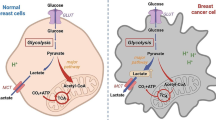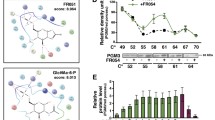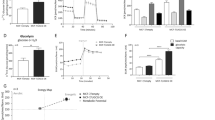Abstract
Purpose
Cancer cells often elicit a higher glycolytic rate than normal cells, supporting the development of glycolysis inhibitors as therapeutic agents. 2-Deoxyglucose (2-DG) is used in this context due to its ability to compete with glucose. However, many studies do not take into account that 2-DG inhibits not only glycolysis but also N-glycosylation. Since there are limited publications on 2-DG mechanism of action in breast cancer, we studied its effects in breast cancer cell lines to determine the part played by glycolysis inhibition and N-linked glycosylation interference.
Methods and Results
2-Deoxyglucose behaved as an anticancer agent with a similar efficiency on cell number decrease between the hormone-dependent MCF-7 and hormone-independent MDA-MB-231 breast cancer cells. It also interfered with the N-linked glycosylation process in both cell lines as illustrated by the migration profile of the lysosomal-associated membrane protein 2 and calumenin. These results are reinforced by the appearance of an abnormal Man7GlcNAc2 structure both on lipid-linked oligosaccharides and N-linked glycoproteins of 2-DG incubated MDA-MB-231 cells. Besides, 2-DG-induced a transient endoplasmic reticulum stress that was more sustained in MDA-MB-231 cells. Both changes were abrogated by mannose. 2-DG, even in the presence of mannose, decreased glycolysis in both cell lines. Mannose partially reversed the effects of 2-DG on cell numbers with N-linked glycosylation interference accounting for 37 and 47% of 2-DG anti-cancerous effects in MDA-MB-231 and MCF-7 cells, respectively.
Conclusion
N-linked glycosylation interference and glycolysis disruption both contribute to the anticancer properties of 2-DG in breast cancer cells.







Similar content being viewed by others
Abbreviations
- 2-DG:
-
2-Deoxyglucose
- BiP:
-
Binding immunoglobulin protein
- CHOP:
-
Transcription factor CEBP homologous protein
- ER:
-
Endoplasmic reticulum
- Glc:
-
Glucose
- GlcNAc:
-
N-Acetylglucosamine
- IC50 :
-
Half maximal inhibitory concentration
- IRE1:
-
Inositol requiring enzyme 1
- LAMP2:
-
Lysosomal-associated membrane protein 2
- LLO:
-
Lipid-linked oligosaccharides
- Man:
-
Mannose
- N-GP:
-
N-linked glycoproteins
- PERK:
-
Pancreatic endoplasmic reticulum kinase-like endoplasmic reticulum kinase
- UPR:
-
Unfolded protein response
- XBP-1:
-
X-box-binding protein-1
References
Koppenol WH, Bounds PL, Dang CV (2011) Otto Warburg’s contributions to current concepts of cancer metabolism. Nat Rev Cancer 11(5):325–337. https://doi.org/10.1038/nrc3038
Gambhir SS (2002) Molecular imaging of cancer with positron emission tomography. Nat Rev Cancer 2(9):683–693. https://doi.org/10.1038/nrc882
Cairns RA, Harris IS, Mak TW (2011) Regulation of cancer cell metabolism. Nat Rev Cancer 11(2):85–95. https://doi.org/10.1038/nrc2981
Gatenby RA, Gillies RJ (2004) Why do cancers have high aerobic glycolysis? Nat Rev Cancer 4(11):891–899. https://doi.org/10.1038/nrc1478
Zhao Y, Butler EB, Tan M (2013) Targeting cellular metabolism to improve cancer therapeutics. Cell Death Dis 4:e532. https://doi.org/10.1038/cddis.2013.60
Porporato PE, Dhup S, Dadhich RK, Copetti T, Sonveaux P (2011) Anticancer targets in the glycolytic metabolism of tumors: a comprehensive review. Front Pharmacol 2:49. https://doi.org/10.3389/fphar.2011.00049
Kuntz S, Mazerbourg S, Boisbrun M, Cerella C, Diederich M, Grillier-Vuissoz I, Flament S (2014) Energy restriction mimetic agents to target cancer cells: comparison between 2-deoxyglucose and thiazolidinediones. Biochem Pharmacol 92(1):102–111. https://doi.org/10.1016/j.bcp.2014.07.021
Nakada HI, Wick AN (1956) The effect of 2-deoxyglucose on the metabolism of glucose, fructose, and galactose by rat diaphragm. J Biol Chem 222(2):671–676
Chen W, Gueron M (1992) The inhibition of bovine heart hexokinase by 2-deoxy-d-glucose-6-phosphate: characterization by 31P NMR and metabolic implications. Biochimie 74(9–10):867–873
Wick AN, Drury DR, Nakada HI, Wolfe JB (1957) Localization of the primary metabolic block produced by 2-deoxyglucose. J Biol Chem 224(2):963–969
Datema R, Schwarz RT (1978) Formation of 2-deoxyglucose-containing lipid-linked oligosaccharides. Interference with glycosylation of glycoproteins. Eur J Biochem 90(3):505–516
Schmidt MF, Schwarz RT, Scholtissek C (1974) Nucleoside-diphosphate derivatives of 2-deoxy-d-glucose in animal cells. Eur J Biochem 49(1):237–247
Kurtoglu M, Gao N, Shang J, Maher JC, Lehrman MA, Wangpaichitr M, Savaraj N, Lane AN, Lampidis TJ (2007) Under normoxia, 2-deoxy-d-glucose elicits cell death in select tumor types not by inhibition of glycolysis but by interfering with N-linked glycosylation. Mol Cancer Ther 6(11):3049–3058. https://doi.org/10.1158/1535-7163.MCT-07-0310
Berthe A, Flament S, Grandemange S, Zaffino M, Boisbrun M, Mazerbourg S (2016) Delta2-Troglitazone promotes cytostatic rather than pro-apoptotic effects in breast cancer cells cultured in high serum conditions. Cell Cycle 15(24):3402–3412. https://doi.org/10.1080/15384101.2016.1245248
Peanne R, Vanbeselaere J, Vicogne D, Mir AM, Biot C, Matthijs G, Guerardel Y, Foulquier F (2013) Assessing ER and Golgi N-glycosylation process using metabolic labeling in mammalian cultured cells. Methods Cell Biol 118:157–176. https://doi.org/10.1016/B978-0-12-417164-0.00010-0
Bravo R, Parra V, Gatica D, Rodriguez AE, Torrealba N, Paredes F, Wang ZV, Zorzano A, Hill JA, Jaimovich E, Quest AF, Lavandero S (2013) Endoplasmic reticulum and the unfolded protein response: dynamics and metabolic integration. Int Rev Cell Mol Biol 301:215–290. https://doi.org/10.1016/b978-0-12-407704-1.00005-1
Tagg SL, Foster PA, Leese MP, Potter BV, Reed MJ, Purohit A, Newman SP (2008) 2-Methoxyoestradiol-3,17-O,O-bis-sulphamate and 2-deoxy-d-glucose in combination: a potential treatment for breast and prostate cancer. Br J Cancer 99(11):1842–1848. https://doi.org/10.1038/sj.bjc.6604752
Wei S, Kulp SK, Chen CS (2010) Energy restriction as an antitumor target of thiazolidinediones. J Biol Chem 285(13):9780–9791. https://doi.org/10.1074/jbc.M109.065466
Zhu Z, Jiang W, McGinley JN, Thompson HJ (2005) 2-Deoxyglucose as an energy restriction mimetic agent: effects on mammary carcinogenesis and on mammary tumor cell growth in vitro. Cancer Res 65(15):7023–7030. https://doi.org/10.1158/0008-5472.CAN-05-0453
Huang YY, Liu H, Li Y, Pu LJ, Jiang CC, Xu JC, Jiang ZW (2013) Down-regulation of RIP1 by 2-deoxy-d-glucose sensitizes breast cancer cells to TRAIL-induced apoptosis. Eur J Pharmacol 705(1–3):26–34. https://doi.org/10.1016/j.ejphar.2013.02.005
Aft RL, Zhang FW, Gius D (2002) Evaluation of 2-deoxy-d-glucose as a chemotherapeutic agent: mechanism of cell death. Br J Cancer 87(7):805–812. https://doi.org/10.1038/sj.bjc.6600547
Kaplan O, Navon G, Lyon RC, Faustino PJ, Straka EJ, Cohen JS (1990) Effects of 2-deoxyglucose on drug-sensitive and drug-resistant human breast cancer cells: toxicity and magnetic resonance spectroscopy studies of metabolism. Cancer Res 50(3):544–551
Vasconcelos-Dos-Santos A, Oliveira IA, Lucena MC, Mantuano NR, Whelan SA, Dias WB, Todeschini AR (2015) Biosynthetic machinery involved in aberrant glycosylation: promising targets for developing of drugs against cancer. Front Oncol 5:138. https://doi.org/10.3389/fonc.2015.00138
Mühlenberg T, Grunewald S, Treckmann J, Podleska L, Schuler M, Fletcher JA, Bauer S (2015) Inhibition of KIT-glycosylation by 2-deoxyglucose abrogates KIT-signaling and combination with ABT-263 synergistically induces apoptosis in gastrointestinal stromal tumor. PLoS ONE 10(3):e0120531. https://doi.org/10.1371/journal.pone.0120531
Peiris D, Spector AF, Lomax-Browne H, Azimi T, Ramesh B, Loizidou M, Welch H, Dwek MV (2017) Cellular glycosylation affects herceptin binding and sensitivity of breast cancer cells to doxorubicin and growth factors. Sci Rep 7:43006. https://doi.org/10.1038/srep43006
Liu H, Kurtoglu M, Cao Y, Xi H, Kumar R, Axten JM, Lampidis TJ (2013) Conversion of 2-deoxyglucose-induced growth inhibition to cell death in normoxic tumor cells. Cancer Chemother Pharmacol 72(1):251–262. https://doi.org/10.1007/s00280-013-2193-y
Ramirez-Peinado S, Leon-Annicchiarico CL, Galindo-Moreno J, Iurlaro R, Caro-Maldonado A, Prehn JH, Ryan KM, Munoz-Pinedo C (2013) Glucose-starved cells do not engage in prosurvival autophagy. J Biol Chem 288(42):30387–30398. https://doi.org/10.1074/jbc.M113.490581
Merchan JR, Kovacs K, Railsback JW, Kurtoglu M, Jing Y, Pina Y, Gao N, Murray TG, Lehrman MA, Lampidis TJ (2010) Antiangiogenic activity of 2-deoxy-d-glucose. PLoS ONE 5(10):e13699. https://doi.org/10.1371/journal.pone.0013699
Ramirez-Peinado S, Alcazar-Limones F, Lagares-Tena L, El Mjiyad N, Caro-Maldonado A, Tirado OM, Munoz-Pinedo C (2011) 2-Deoxyglucose induces Noxa-dependent apoptosis in alveolar rhabdomyosarcoma. Cancer Res 71(21):6796–6806. https://doi.org/10.1158/0008-5472.CAN-11-0759
Galluzzi L, De Santi M, Crinelli R, De Marco C, Zaffaroni N, Duranti A, Brandi G, Magnani M (2012) Induction of endoplasmic reticulum stress response by the indole-3-carbinol cyclic tetrameric derivative CTet in human breast cancer cell lines. PLoS ONE 7(8):e43249. https://doi.org/10.1371/journal.pone.0043249
Zang C, Liu H, Bertz J, Possinger K, Koeffler HP, Elstner E, Eucker J (2009) Induction of endoplasmic reticulum stress response by TZD18, a novel dual ligand for peroxisome proliferator-activated receptor alpha/gamma, in human breast cancer cells. Mol Cancer Ther 8(8):2296–2307. https://doi.org/10.1158/1535-7163.mct-09-0347
Zinszner H, Kuroda M, Wang X, Batchvarova N, Lightfoot RT, Remotti H, Stevens JL, Ron D (1998) CHOP is implicated in programmed cell death in response to impaired function of the endoplasmic reticulum. Genes Dev 12(7):982–995
Colin-Cassin C, Yao X, Cerella C, Chbicheb S, Kuntz S, Mazerbourg S, Boisbrun M, Chapleur Y, Diederich M, Flament S, Grillier-Vuissoz I (2015) PPARγ-inactive ∆2-troglitazone independently triggers ER stress and apoptosis in breast cancer cells. Mol Carcinog 54(5):393–404. https://doi.org/10.1002/mc.22109
Zagorodna O, Martin SM, Rutkowski DT, Kuwana T, Spitz DR, Knudson CM (2012) 2-Deoxyglucose-induced toxicity is regulated by Bcl-2 family members and is enhanced by antagonizing Bcl-2 in lymphoma cell lines. Oncogene 31(22):2738–2749. https://doi.org/10.1038/onc.2011.454
Leon-Annicchiarico CL, Ramirez-Peinado S, Dominguez-Villanueva D, Gonsberg A, Lampidis TJ, Munoz-Pinedo C (2015) ATF4 mediates necrosis induced by glucose deprivation and apoptosis induced by 2-deoxyglucose in the same cells. FEBS J 282(18):3647–3658. https://doi.org/10.1111/febs.13369
Cheng G, Zielonka J, Dranka BP, McAllister D, Mackinnon AC Jr, Joseph J, Kalyanaraman B (2012) Mitochondria-targeted drugs synergize with 2-deoxyglucose to trigger breast cancer cell death. Cancer Res 72(10):2634–2644. https://doi.org/10.1158/0008-5472.CAN-11-3928
Xi H, Kurtoglu M, Liu H, Wangpaichitr M, You M, Liu X, Savaraj N, Lampidis TJ (2011) 2-Deoxy-d-glucose activates autophagy via endoplasmic reticulum stress rather than ATP depletion. Cancer Chemother Pharmacol 67(4):899–910. https://doi.org/10.1007/s00280-010-1391-0
Xi H, Kurtoglu M, Lampidis TJ (2014) The wonders of 2-deoxy-d-glucose. IUBMB Life 66(2):110–121. https://doi.org/10.1002/iub.1251
Funding
This project was funded by University of Lorraine and Région of Lorraine. Audrey Berthe and Claire Muller were recipient of a PhD grant of the “Ministère de l’Enseignement Supérieur et de la Recherche”.
Author information
Authors and Affiliations
Corresponding author
Ethics declarations
Conflict of interest
The authors declare that the research was conducted in the absence of any commercial or financial relationships that could be construed as a potential conflict of interest.
Rights and permissions
About this article
Cite this article
Berthe, A., Zaffino, M., Muller, C. et al. Protein N-glycosylation alteration and glycolysis inhibition both contribute to the antiproliferative action of 2-deoxyglucose in breast cancer cells. Breast Cancer Res Treat 171, 581–591 (2018). https://doi.org/10.1007/s10549-018-4874-z
Received:
Accepted:
Published:
Issue Date:
DOI: https://doi.org/10.1007/s10549-018-4874-z




